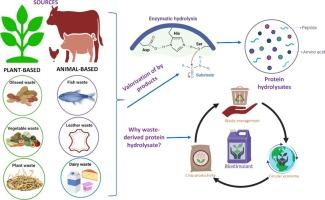从废物到奇迹:蛋白质水解物在农业中作为植物生物刺激素的潜力
Q1 Environmental Science
引用次数: 0
摘要
从植物和动物副产品中提取的蛋白质水解物(PHs)已成为可持续农业中有前途的生物刺激素。本文综述了小灵通在促进植物生长和抗逆性中的产生、组成和作用机制。小灵通是通过酶水解富含蛋白质的废物得到的,产生氨基酸和生物活性肽的混合物。商业小灵通在各种农业和园艺物种中表现出多种效应,包括增强养分吸收、非生物胁迫耐受性和作物产量。小灵通的生物刺激活性可归因于多种相互关联的途径,如激素样信号传导、抗氧化防御、渗透调节和基因表达调节。此外,小灵通影响植物微生物组,可能有助于改善逆境适应。叶面和根部施用方式,以及pH和转运体等因素,控制着植物对pH的吸收和转运。转录组学和蛋白质组学研究为ph介导的促进生长和缓解应激的分子机制提供了见解。未来的研究应侧重于优化PH配方,探索与其他生物刺激剂的协同作用,并阐明植物与微生物相互作用的作用。通过利用这些可持续化合物的潜力,PH生物刺激剂为提高农业生产力和抵御全球挑战提供了一种有希望的方法。本文章由计算机程序翻译,如有差异,请以英文原文为准。

From waste to wonder: The potential of protein hydrolysates as plant biostimulants in agriculture
Protein hydrolysates (PHs) derived from plant and animal byproducts have emerged as promising biostimulants in sustainable agriculture. This comprehensive review investigates the production, composition, and mechanisms of action of PHs in promoting plant growth and stress resilience. PHs are obtained through enzymatic hydrolysis of protein-rich waste, yielding mixtures of amino acids and bioactive peptides. Commercial PHs exhibit diverse effects, including enhanced nutrient uptake, abiotic stress tolerance, and crop yield in various agricultural and horticultural species. The biostimulant activity of PHs is attributed to multiple interconnected pathways, such as hormone-like signalling, antioxidant defense, osmotic regulation, and gene expression modulation. Moreover, PHs influence the plant microbiome, potentially contributing to improved stress adaptation. Foliar and root application methods, along with factors like pH and transporters, govern PH absorption and translocation in plants. Transcriptomic and proteomic studies have provided insights into the molecular mechanisms underlying PH-mediated growth promotion and stress mitigation. Future research should focus on optimizing PH formulations, exploring synergies with other biostimulants, and elucidating the role of plant-microbe interactions. By harnessing the potential of these sustainable compounds, PH biostimulants offer a promising approach to enhance agricultural productivity and resilience in the face of global challenges.
求助全文
通过发布文献求助,成功后即可免费获取论文全文。
去求助
来源期刊

Bioresource Technology Reports
Environmental Science-Environmental Engineering
CiteScore
7.20
自引率
0.00%
发文量
390
审稿时长
28 days
 求助内容:
求助内容: 应助结果提醒方式:
应助结果提醒方式:


